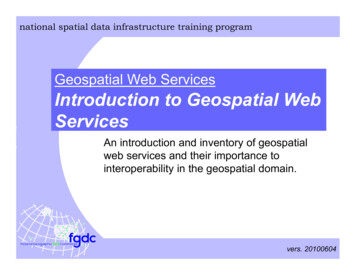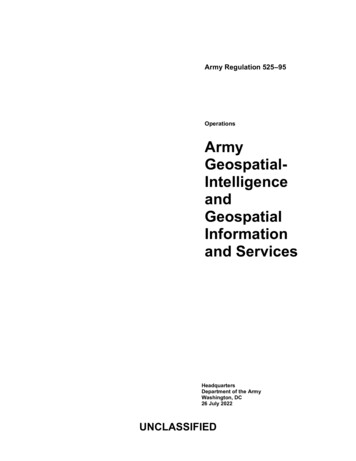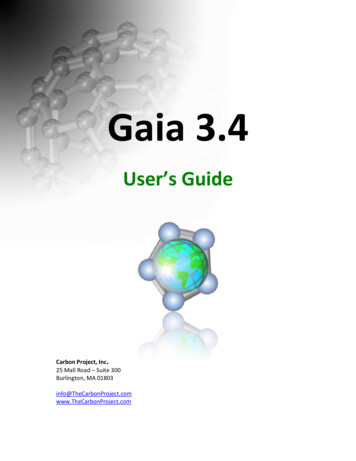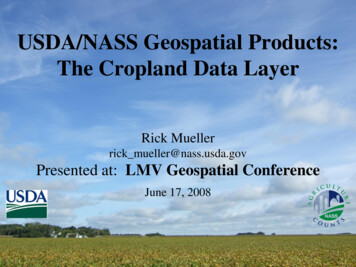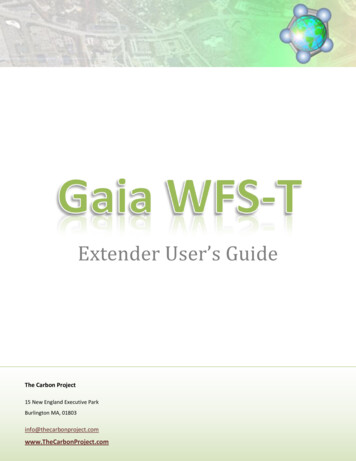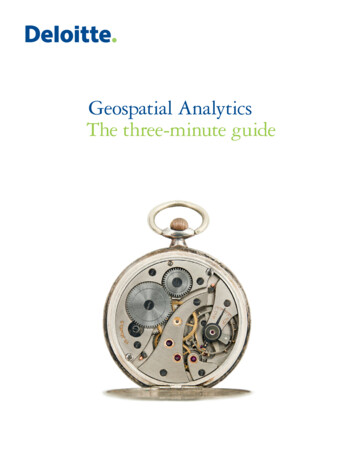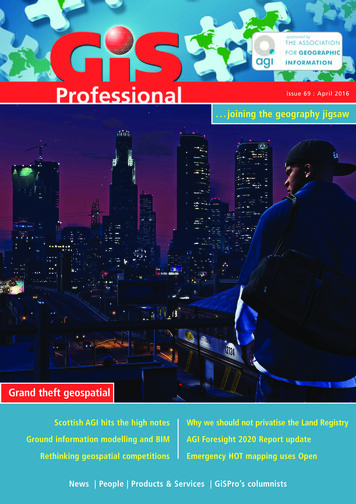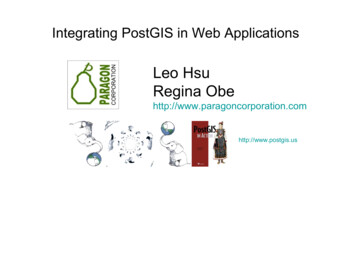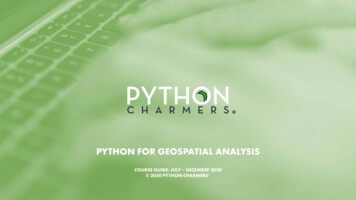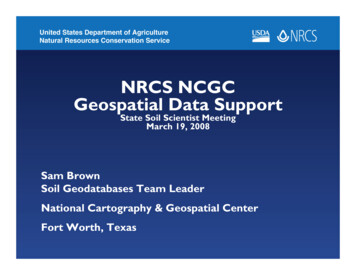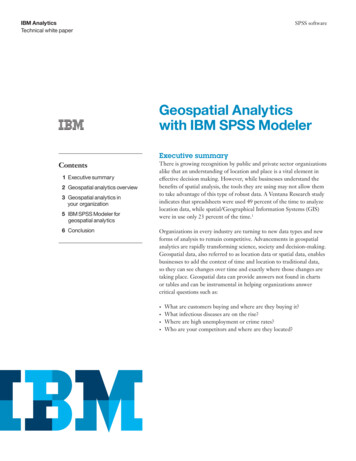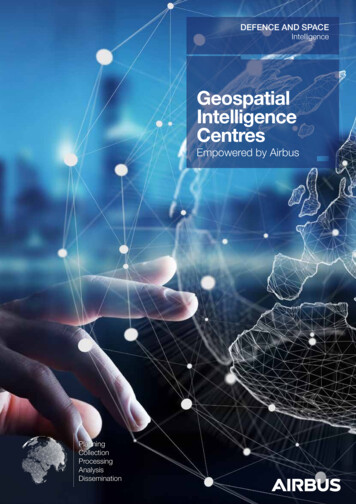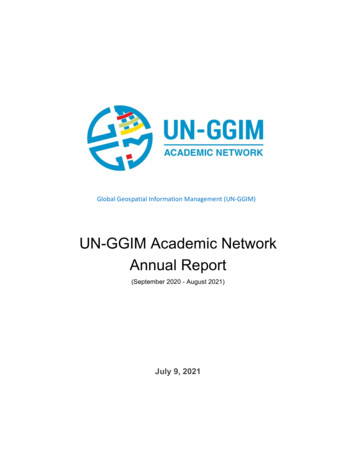
Transcription
Global Geospatial Information Management (UN-GGIM)UN-GGIM Academic NetworkAnnual Report(September 2020 - August 2021)July 9, 2021
Message from ChairDespite the COVID pandemic, the activity of the Network has been very relevant in the last year.The second part of 2020 was mainly devoted to administrative procedures, specifically theelections of the new Executive Committee and Advisory Board. The beginning of 2021 wasmarked by the handover and the identification of the new representatives of the Network in all thebodies of the UN-GGIM. The response of the members to the request for cooperation wasenthusiastic, especially in some working groups, such as that on Geospatial Information andServices for Disasters.The Executive Committee, with the support of the Advisory Board, has worked on revising theNetwork’s Terms of Reference (ToR), based on the previous one but taking into account theexperience gained over the last few years. The new ToRs is attached to this report. One of themost relevant points was the inclusion of a new category of membership, which was calledassociate member. The associate member is an recognized, non-academic/research entities(e.g., academic publishers and education divisions/centers of companies), who wishes toparticipate in and/or contribute to the Network and whose business or operation is relevant to theaspects of education and research in the areas of interest of the UN-GGIM, with an establishedtrack record. The main purpose of this new category of members is to be inclusive with respectto external contributions and increase the collaboration of the Network outside the Academia.While revising the new ToRs, the Executive Committee worked on updating the website anddeveloping some procedures that are more efficient, such as the voting procedure for newmembers. A shared repository and a shared email address among the members of the ExecutiveCommittee have also been defined for easier documentation management. When there are newelections and therefore a new Executive Committee, it will be easier to be able to pass all thedocumentation to the next governance.The pandemic accustomed the members of the Network to meet remotely and therefore therewas no difficulty in setting up a monthly meeting among the members of the Executive Committee,the Advisory Board, and the Representatives of the Regional Committees. In the future, it isexpected to have extended meetings also to all interested members of the Network.Despite the more complex situation due to the pandemic, all the commitments planned for thecurrent year have been continued. In particular, two books have been published and threeinitiatives, which have seen the involvement of various members of the Network, have beendeveloped to support the activities of the United Nations.All these actions were possible thanks to the commitment and continuous activities of themembers of the Network, the Advisory Board members and the Regional Representatives. Iwould like to express my gratitude to them for their valuable contributions.Maria Antonia BrovelliChair, UN-GGIM Academic Network, July 20212
Meetings and AdministrationElection of the new UN-GGIM Academic Network governance bodies has occurred in November2020, and, as a result, the new officers and board members for January 2021 - December 2022are as follows:EXECUTIVE COMMITTEE:CHAIR: Maria Antonia Brovelli, Politecnico di Milano, ItalyDEPUTY CHAIR: Songnian Li, Ryerson University, CanadaSECRETARY: Ivana Ivánová, Curtin University, AustraliaADVISORY BOARD:Cheryl Desha, Griffith University, AustraliaGeorg Gartner, Vienna University of Technology, AustriaMenno-Jan Kraak, University of Twente/ITC, NetherlandsJonathan Li, University of Waterloo, CanadaAbbas Rajabifard, University of Melbourne, Australia (Immediate Past President)Michael Starek, Texas A&M University - Corpus Christi, USAHuayi Wu, Wuhan University, ChinaREGIONAL REPRESENTATIVES:AFRICA: Serena Coetzee, University of Pretoria, South AfricaAMERICAS: Rosario Casanova, Lincoln Institute of Land Policy, UruguayASIA-PACIFIC: Huayi Wu, wuhan University, ChinaEUROPE: Joep Crompvoets, Katholieke Universiteit Leuven, BelgiumGOVERNANCE OPERATION (January - June 2021):The newly elected Executive Committee commenced its activities in January 2021 with transitionof the governance from the previous team, including creating a sustainable workspace for theNetwork and updating and restructuring the Network’s website.The Executive Committee has revised Network’s Terms of Reference. Updated Terms ofReference were endorsed by the members of the Network’s Advisory Board, and the documentwas reviewed by the UN-GGIM Secretariat. One important change made to the ToRs in thisrevision is the introduction of the new membership category, i.e., Associate Member. The newcategory will allow non-academic entities such as R&D divisions of companies, non-for-profitorganizations, NGOs, etc. to participate in the Academic Network.UN-GGIM Academic Network’s Executive Team, Advisory Board and Regional Representativesvirtually meet monthly.3
MembershipCurrently, the Network has 55 members from 34 different countries (see a map of memberdistribution in Figure 1). The details of the members are available on the Network website. SinceAugust 2020, the network has admitted four new members: Lund University, University ofWinnipeg, Polytechnic University of Valencia, and approval of two applications are currentlypending.Figure 1. Geographical distribution of the current Network membersIn March 2021, the Executive Committee invited members to volunteer as the Network’srepresentatives in other UN-GGIM bodies and working groups. The response from members wasoverwhelmingly positive – see in Appendix the list of current Network’s representatives in eachUN-GGIM body or working group.ActivitiesPARTICIPATION IN UN-GGIM EVENTSUN-GGIM Events were communicated to all members of the Network and a large participationwas seen in the events. The Advisory Board member is currently working in organizing the SideEvent of the Eleventh Session. It will be focused on Education and Capacity Building with a panelinvolving both members of the Academic Network and Experts on Global Geospatial InformationManagement (Regional Committees, Working Groups, and Thematic Networks).4
CADASTRAL TEMPLATE 2.0 AND SUSTAINABLE DEVELOPMENTThe "Cadastral Template 2.0" is a platform developed by the University of Melbourne Centre for SDIsand Land administration (CSDILA), a member of the UN-GGIM Academic Network, in collaborationwith FIG-Commission 7 (a member of UN-GGIM Geospatial Societies) and was initially establishedunder UN mandate by Resolution 4 of the UN-GGIM AP (previously UNRCC-AP) in Okinawa, Japanin 2003. In 2018 with an offer from the Academic Network, UN-GGIM has acknowledged and adoptedthis platform as a valuable global resource to assist UN-GGIM activities. The cadastral templateplatform placed the country land and cadastre information that offers comparative analysis tools tomeasure and indicate country performance in cadastre and land information in comparison with othercountries, to assist country growth. Currently the platform provides the data collected over 50countries.As a result of the adoption action of the cadastral template platform by the UN-GGIM, the AcademicNetwork as part of its work plan 2019-2022, has defined a research project to investigate and discussglobal trends in land tenure registration and advancement in cadastre and land informationmodernization, to propose effective national and global solutions with an emphasis on implementationof the UN-SDGs. The project is a spatial data foundation for sustainable development and thesignificant role of land information to facilitate the SDGs. Because of the COVID pandemic situation,the project has started in late 2020 and is currently at its design methodology and formulation ofindicators that are in line with UN-SDGs goals to conduct a global survey during 2021-2022.UN-GGIM INTEGRATED GEOSPATIAL INFORMATION FRAMEWORK (IGIF)Several members of the Network contributed to the creation and consultation of UN-GGIMIntegrated Geospatial Information Framework (IGIF), and organized and/or actively participatedin outreach activities related to IGIF between 2020 and 2021.GEOSPATIAL RESEARCH AND INNOVATION IN IMPLEMENTING SDGSAs part of work plan 2019-2022, the Academic Network has defined a research project to Leveragingspatial data infrastructure and integrated analytical platform to support implementation, benchmarking,measuring and monitoring the SDG indicators. This research project is investigating the challenges ineffective and sustained access to digital technology, the Internet of Things (IoT), to the provision andexploitation of new data needs, information systems, analytics and associated enabling tools, andtechnologies to support the timely and reliable implementation and monitoring of the progress in SDGs.The activities and benefits of the project include: Enhancing the methodologies and implementation frameworks to support evidence-basedpolicy making towards achieving the SDGs Formalizing reusable geospatial tools for producing the SDG indicators, enablingbenchmarking and comparison Designing a dynamic platform rather than available static dashboards Supporting national and local jurisdiction to improve their current static monitoringdashboards Assisting governments to predict the future trends of SDG indicators.5
UN OPEN GIS INITIATIVEThe UN Open GIS Initiative is a Partnership Initiative led by the United Nations GeospatialOperations. The Initiative, established in March 2016, is supported by several UN Member States,UN Field Missions, UN Agencies, and technology-contributing partners (internationalorganizations, academia, NGOs, and the private sector), and takes full advantage of theirexpertise. The aim is the creation of an extended spatial data infrastructure that meets therequirements of the UN Secretariat (including UN field missions and regional commissions), andthen expands to UN agencies, UN operating partners and developing countries. Contribution ofthe Academic Network members are summarized as follows: Several members active in the OSGeo’s UN Initiative, which organizes online training forthe UN, staff on open source technologies, specifically on PostGIS and QGIS.Development of a training course on advanced QGIS functionalities atest/.Organization of challenges to produce new education material (supported by sgeo-un-committee-educationalchallenge/. Organization with the UN Global Pulse, Food and AgricultureOrganization (FAO) of an open consultation to share current UNactivities and aspirations in the field of Geo-AI; share non-UNresearch and operations in the use of Geo-AI; gather feedback fromthe various stakeholders present on priorities, partnerships andcollaborations in the Geo-AI space; and determine potentialcollaborations between communities of practice to promote andfurther support UN-system operational response.The consultation report is available as an open document /2020/11/UNOpenGIS WG5 report final.pdf Organization with ITU and within the AI For Good Global Summit of a workshop on“Satellite data analysis and Machine Learning classification with QGIS”. The workshop,divided in two parts, was made available later on YouTube. Some statistics of theworkshop are available in the table below.PartUniqueUnique viewsAttendee (20 June 2021)YouTube Video be.com/watch?v DLeG0Z3al9I72 %2896491https://www.youtube.com/watch?v 8b5fPxN6qQ473 %6
BOOKSThe book “Rajabifard, A., Foliente, G., & Paez, D. (2021). COVID-19Pandemic, Geospatial Information, and Community Resilience: GlobalApplications and Lessons (1st Ed.). CRC Press” was published on 10 June202.It collects many contributions of members of the network in response to thepandemic challenge. It provides multi-sectorial expertise on the use ofgeospatial information and location intelligence to support communityresilience and authorities to manage such situations.It is available as Open Book (Creative Commons, CC BY-NC-ND) -foliente-daniel-paezThe book “Kraak MJ, RE Roth, B Ricker, A Kagawa, and G Le Sourd. 2020.Mapping for a Sustainable World. The United Nations: New York, NY (USA)”, aco-publication by the United Nations and the International CartographicAssociation, was presented on the International Day of Education (24 January2021). The book has an editorial team comprising writers from the InternationalCartographic Association (ICA) and the Geospatial Information Section of theUnited Nations (UN). It is published as an open access document (CC-BY-NClicense). The pdf-version of the book can be downloaded from the pageaccessible via the following link tions and PromotionThe UN-GGIM Academic Network communicates with members from a newly set-up emailaccount: unggim.academicnetwork@gmail.com.Information about member news and interesting events are posted on Network’s ts/Members are regularly promoting the UN-GGIM Academic Network and its activities via theirnetworks - for example, there was a presentation about Network’s activities at UN-GGIM AsiaPacific Extended Bureau meeting in May 2021, Economic Commission for Africa at the 6thmeeting of UN-GGIM Africa in December 2020, and at the 52nd ISO/TC211 Plenary Meeting inJune 2021.Future PlanOne of the main missions of the UN-GGIM Academic Network is education and capacity building.The pandemic has obliged us to consider new ways of teaching and we can think of reusing what7
we learned in the last months also for reaching a wider floor, pushing ahead the knowledge in thegeo-spatial domain. The network started already discussing both educationalplatforms/repositories/courses and the necessity of considering also new topics which areoverwhelmingly emerging also in the geospatial world. One possible contribution is therefore toissue a white paper on innovation in the global geospatial education, considering both the meansand the content.The following is a list of activities the Network has planned for the year 2021-2022, besidescontinuing the long-term initiatives already active in the previous year: Workshop on the Development of High-education in Geospatial Information: the workshopwill be open to all members and associate members of the Network but also open to otherparticipants. The plan is to organize it in-person, if the pandemic situation allows. Theexpected time is later 2021 or early 2022. Biennial General Meeting (BGM): this meeting aims at gathering the Network members todiscuss important issues concerned by the entire network membership. BGM will be heldright before the next UN-GGIM Session (June/July 2022).The Network will further strengthen the relationships and cooperation of the Network’s memberswith the other bodies of UN-GGIM, for instance collaborating in pilot projects with the PrivateSector Network.8
Appendix: Table of UN-GGIM Academic Network’s delegates toother UN-GGIM functions or working groups.UN-GGIM AfricaMaria Antonia Brovelli Politecnico di Milanomaria.brovelli@polimi.itSerena CoetzeeUniversity of Pretoriaserena.coetzee@up.ac.zaUN-GGIM AmericasSongnian LiRosario CasanovaRyerson UniversityUniversity of the Republic - Uruguaysnli@ryerson.cacasanova@fing.edu.uyUN-GGIM Arab StatesMaria Antonia Brovelli Politecnico di MilanoMarouane evens.eduUN-GGIM Asia-PacificIvana IvanovaCurtin UniversityHuayi WuWuhan du.cnUN-GGIM EuropeJoep CrompvoetsJosef ac.atKU LeuvenUniversity of SalzburgUN-GGIM Expert Group on the Integration of Statistical and Geospatial InformationGeorg GartnerTechnical University Viennageorg.gartner@tuwien.ac.atMilap PuniaJawaharlal Nehru Universitypunia@mail.jnu.ac.inUN-GGIM Working Group on Legal and Policy Frameworks for Geospatial InformationManagementDouglas Richardson Harvard University - Center fordbrichardson@fas.harvard.eduGeographic AnalysisPaul BoxCSIROpaul.j.box@csiro.auUN-GGIM Inter-Agency and Expert Group on Sustainable Development Goals Indicators(IAEG-SDGs)Songnian LiRyerson Universitysnli@ryerson.caAbbas RajabifardUniversity of Melbourneabbas.r@unimelb.edu.auUN-GGIM Geospatial SocietiesMenno-Jan KraakUniversity of Twentem.j.kraak@utwente.nl9
BuiFIMO Center, Vietnam NationalUniversity of Engineering andTechnology, Hanoi, Vietnamhungbq@fimo.edu.vnUN-GGIM Private Sector NetworkCheryl DeshaGriffith Universityc.desha@griffith.edu.auFraser TaylorGeomatics and Cartographic Research fraser.taylor@carleton.caCentre , Carleton University ,Ottawa ,CanadaBuiFIMO Center, Vietnam Nationalhungbq@fimo.edu.vnUniversity of Engineering andTechnology, Hanoi, VietnamUN-GGIM Working Group on Geospatial Information and Services for DisastersHuayi WuWuhan Universitywuhuayi@whu.edu.cnPaola CarraraCNR IREAcarrara.p@irea.cnr.itUN-GGIM Expert Group on Land Administration and ManagementGary JEFFRESSTexas A&M University-Corpus Christigary.jeffress@tamucc.eduMiro GovedaricaUniversity of Novi Sad, Faculty ofmiro@uns.ac.rsTechnical ScienceUN-GGIM Subcommittee on Geodesy (formerly WG on Global Geodetic ReferenceFrame)Ivana IvanovaCurtin Universityivana.ivanova@curtin.edu.auRiccardo BarzaghiPolitecnico di Milanoriccardo.barzaghi@polimi.itUN-GGIM Working Group on Marine Geospatial InformationPalanisamyIndian Institute of Technology Madraspshanmugam@iitm.ac.inShanmugamBuiFIMO Center, Vietnam Nationalhungbq@fimo.edu.vnUniversity of Engineering andTechnology, Hanoi, Vietnam10
Organization with ITU and within the AI For Good Global Summit of a workshop on "Satellite data analysis and Machine Learning classification with QGIS". The workshop, divided in two parts, was made available later on YouTube. Some statistics of the workshop are available in the table below.
